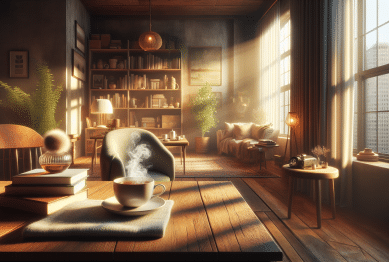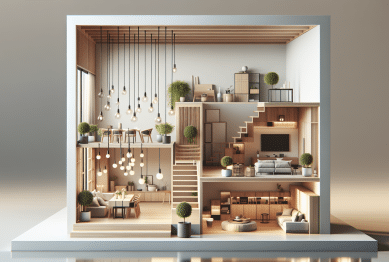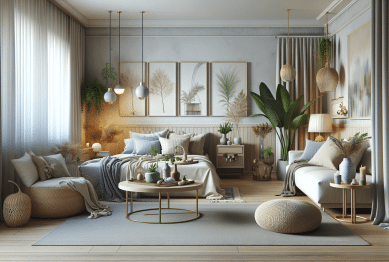Transforming your living space into a sanctuary is simpler than you might expect. Discover practical lifestyle tips for boosting comfort, maximizing relaxation, and bringing mindful entertainment into your home with solutions that suit every budget and style. Learn what truly elevates an atmosphere without overpromising or requiring large investments.
Understanding the Power of Home Atmosphere
Home atmosphere sets the tone for daily life. The feeling you experience when entering your space—calm, energized, or cluttered—often comes from subtle design details. Comfort does not require expensive updates. Instead, small touches can dramatically influence well-being. Think throw blankets, soft lighting, and intentional arrangement of cherished items (Source: https://www.psychologytoday.com/us/blog/right-your-home/202012/make-your-home-your-sanctuary). Integrating soothing colors or objects that hold meaning to you can significantly elevate your home’s ambience.
Lifestyle choices impact the energy in a home. Scented candles, gentle music, and the presence of houseplants are proven ways to reduce stress and foster relaxation. Incorporating mindful entertainment such as board games, podcasts, and light reading creates gathering moments that enrich everyday routines. Intentionally curating your acoustic environment—like choosing calming playlists—can also help regulate emotions and stress levels. Every item you choose shapes the atmosphere uniquely.
Technology enables personalization. Smart lighting and ambient sound devices let residents effortlessly tailor the mood. However, a sense of sanctuary goes beyond gadgets. Surround yourself with items you love, whether books, photos, or comfortable seats. Prioritize functionality and warmth. Even entry-level ergonomic furniture can significantly boost relaxation and mood, making your home more inviting for yourself and guests.
Choosing Comfort Essentials on Any Budget
Affordability is achievable for a cozy decor upgrade. Layering with throw pillows, affordable area rugs, and soft textiles creates instant comfort. Shop at discount stores, thrift markets, or repurpose items you already have to keep the process budget-friendly (Source: https://www.hgtv.com/lifestyle/clean-and-organize/turn-your-home-into-a-sanctuary). Focus on texture. Mixing blankets and cushions of varying fabrics will make a big impact—without straining your budget. Sometimes all it takes is a cozy nook by a sunlit window to create the perfect retreat.
Secondhand finds add character and warmth. Vintage lamps, gently used seating, or quirky artwork offer affordable personality. Some individuals even swap decor items with friends, refreshing their environment without additional expense. Living plants, which are available for reasonable prices at many stores and markets, not only purify the air but also enhance well-being. Home design is not about expensive trends; it’s about adaptable comfort.
Do-it-yourself projects encourage creativity and mindfulness. Simple activities—like painting plant pots, sewing throw covers, or assembling an art wall—provide entertainment and a sense of accomplishment. Crafting can be a form of personal expression that expands your comfort zone and creates deeper attachment to your surroundings. Explore tutorials or community workshops for inspiration. A mindful approach to decorating makes your home uniquely tailored to your values and needs.
Embracing Mindful Entertainment at Home
Entertainment can become a path to mindful living when intentionally curated. Rather than defaulting to screens, consider activities that engage multiple senses and build connection. Board games, music nights, or collaborative cooking sessions offer memorable experiences that draw people together. Carefully chosen entertainment encourages relaxation and nurtures relationships for all ages (Source: https://www.nytimes.com/2021/03/12/realestate/create-a-sanctuary-at-home.html).
Reading, journaling, and puzzle-solving help create quiet pockets of restoration in the home. Designate a corner as your entertainment nook—add a plush chair or floor cushion, soft lighting, and a small stack of favorite books or games. Inviting spaces reduce stress and invite creativity. Shared entertainment, like casual movie nights with homemade snacks or themed playlists, establishes comforting rituals and highlights the value of being present together.
Virtual events and interactive platforms provide social opportunities even while staying in. From online trivia challenges to live streamed concerts, digital experiences can be as immersive as in-person gatherings. The flexibility of virtual entertainment brings communities and families together across distances. Select events that align with your interests and values—this enhances both enjoyment and well-being. Flexible entertainment approaches suit every personality and home dynamic.
Incorporating Calming Design Principles
Design shapes emotion. Soft, neutral palettes, minimal clutter, and natural elements like wood or greenery generate soothing spaces. Adopting calming design principles does not require professional help. Focus on reducing visual noise by storing away items not used daily. Position seating by windows for maximum daylight and arrange furniture to promote easy movement. The psychology of color—pastels, earthy hues, or blues—can subtly transform mood (Source: https://www.verywellmind.com/how-to-create-a-calming-home-5111183).
The strategic use of lighting helps regulate circadian rhythms. Try warm-toned bulbs in living spaces and dimmable options for evenings. Layer task light with ambient, ensuring each room can shift from productivity to relaxation. Plants provide a living connection to nature—peace lilies, snake plants, or philodendrons are resilient and forgiving for beginners. Mirrors can spread light and open up smaller spaces, making rooms feel more expansive and peaceful.
Minimalism can help those seeking clarity. Reducing possessions to the essentials frees up space for creativity and, paradoxically, increases feelings of abundance. Identify items that spark joy and keep them accessible, while storing or donating things that no longer serve you. When every item has a place and a purpose, daily maintenance feels lighter, and your surroundings become more restorative. Live with intention, not excess.
Prioritizing Wellness Routines in Everyday Life
A sanctuary should support both mind and body. Creating a daily wellness routine might involve a simple stretch session, a few minutes of meditation, or a regular cup of calming herbal tea. Emotional routines—such as gratitude journaling or mindful breathing—are as significant as physical practices. Make your self-care materials easily accessible. Having a designated wellness space, even a small one, creates consistency and encourages daily engagement (Source: https://www.health.harvard.edu/mind-and-mood/creating-a-haven-at-home).
Digital wellness deserves mention. Limit screen time and consider boundaries for phones or computers, especially in rest areas. Blue-light filtering bulbs, unplugged winddown rituals, or curated playlists for restful evenings help maintain balance. Choosing media and content that inspire and uplift contributes to a peaceful home environment. Balance active entertainment with restoration; both are necessary for holistic wellness.
Incorporate family or roommate participation in wellness. Group activities—gentle yoga, outdoor walks, or themed dinners—strengthen bonds and make healthy habits enjoyable. Sharing mindful entertainment and supportive routines leads to mutual encouragement and reduces stress for all. The journey to sanctuary living is ongoing and benefits from collaboration and regular reflection. Pause often to appreciate your evolving space and routines.
Refreshing and Maintaining Your Sanctuary Over Time
Spaces and lifestyles evolve. Regularly refresh your home by rotating decor, adding seasonal blooms, or updating playlists. Small changes help spaces feel lively and inspire creativity (Source: https://extension.umn.edu/news/tips-creating-home-sanctuary). Clear out expired pantry items, donate unused belongings, and create new traditions around tidying. Involve all household members for a collaborative refresh. Revisiting the flow and function of rooms ensures continued adaptation to your needs.
Maintenance shouldn’t be a chore. Establish tiny rituals, like weekly flower-arranging or monthly deep-cleaning, that make upkeep satisfying. Consider a seasonal or quarterly review to address repairs, rearrange furniture, and introduce meaningful objects. Continuous improvement helps prevent stagnation and keeps homes feeling personal and special. Trust your intuition—keep what feels right, and let go of what doesn’t. Celebrate progress.
Keep an open mind about new entertainment trends or wellness products, but filter options through your own values and comfort. Not all gadgets or hobbies will suit your space. Remember: sanctuary comes from a sense of safety, self-expression, and mindful choices. Your evolving sanctuary reflects not trends, but the unique combination of personality, habits, and joy cultivated inside your home.
References
1. Psychology Today. (n.d.). Make Your Home Your Sanctuary. Retrieved from https://www.psychologytoday.com/us/blog/right-your-home/202012/make-your-home-your-sanctuary
2. HGTV. (n.d.). Turn Your Home Into a Sanctuary. Retrieved from https://www.hgtv.com/lifestyle/clean-and-organize/turn-your-home-into-a-sanctuary
3. The New York Times. (2021). Create a Sanctuary at Home. Retrieved from https://www.nytimes.com/2021/03/12/realestate/create-a-sanctuary-at-home.html
4. Verywell Mind. (n.d.). How to Create a Calming Home. Retrieved from https://www.verywellmind.com/how-to-create-a-calming-home-5111183
5. Harvard Health Publishing. (n.d.). Creating a Haven at Home. Retrieved from https://www.health.harvard.edu/mind-and-mood/creating-a-haven-at-home
6. University of Minnesota Extension. (n.d.). Tips for Creating a Home Sanctuary. Retrieved from https://extension.umn.edu/news/tips-creating-home-sanctuary









